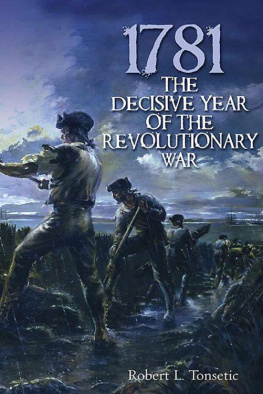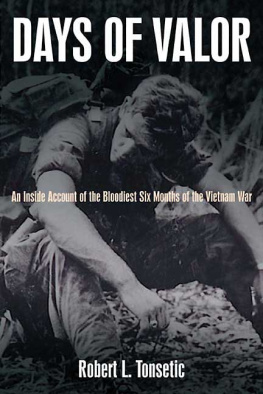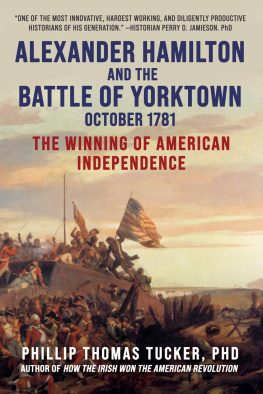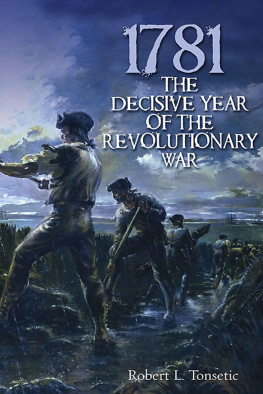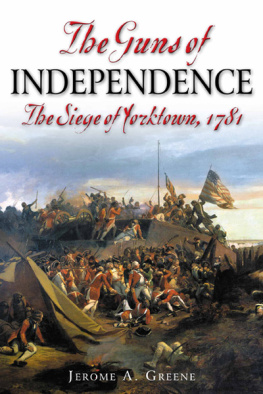



CONTENTS
PART I: A WINTERS TALE
PART II: NO SPRING NOR SUMMER REST
PART III: THE GUNS OF AUTUMN
For
Miranda and Mitchell
I have the honor to inform Congress, that a reduction of the
British Army under the Command of Lord Cornwallis,
is most happily effected.
General George Washington to the President of the
Continental Congress, October 19, 1781
PROLOGUE

This book traces the events of one of those rare years in American history, when the fate of the nation hung in the balance, and only the fortitude, determination, and sacrifices of its leaders and citizenry could save it. After six years of war, the new nation faced seemingly insurmountable challenges and difficulties. Like the years 1776, 1865, and 1945, the year 1781 changed the course of American and, indeed, world history.
By 1780, the Revolutionary War in the northern theater had reached a stalemate. The British army continued to occupy New York City with some 7,000 troops, while most of the American army was deployed in a wide arc from northern New Jersey across the Hudson highlands and on into New England. However, after six years of war, the American army was fast approaching the breaking point. The troops were in a worse situation than ever before, including the harsh winter of 177778 at Valley Forge. By January of 1781, the number of Continental troops had shrunk from a high of nearly 23,000 men in 1778 to a meager force of less than 10,000. The Americans faced other problems as well.
The American army was critically short on all classes of military supplies and equipment, including muskets, artillery, and ammunition of all types, as well as uniforms, blankets, tents, and medical supplies. Additionally, General George Washington found it increasingly difficult to feed his troops. Lacking funds to make purchases, Washington had to resort to requisitioning food and other supplies from surrounding farms and towns, angering the war weary and increasingly apathetic civilian population. Making matters worse, the troops had not been paid in months, and many were nearing what they believed to be the end of their three-year enlistments. When the three-year soldiers were told that their enlistments were actually for the duration of the war, threats of mutiny reverberated through the camps.
There was little Washington could do to resolve the shortages of supplies, lack of pay, and disputes over enlistment contracts. He kept Congress fully informed of the armys requirements, but the U.S. Treasury was empty, and the value of Continental paper money had plummeted to the point that it was considered worthless. Moreover, Congress had no power over the states to levy taxes to fund the war or draft men for the army. Each state was largely responsible for enlisting, clothing, equipping, and paying its own troops, and Washington could only appeal to Congress and state governments to fulfill their obligations to the army. As a result, recruitment of new soldiers for the Continental Army became next to impossible, and the enlistments and drafts from the state militias proved inadequate to replace the armys personnel losses.
Americas alliance with the French was also under severe strain. Beginning in 1777, France had supplied the Americans with large quantities of armaments, munitions, clothing, and money, but by 1780 the flow of supplies and funds had slowed to a trickle. Disappointed by the lack of progress in the war, the French Foreign Minister Vergennes proposed a summit of European powers to mediate a peace conference between the belligerents. A ray of hope arrived in July of 1780, when a small French fleet arrived off Newport, Rhode Island, and landed some 6,000 French troops under the command of General Comte de Rochambeau. However, the French General was reluctant to begin combined operations with the Americans before the remaining 2,000 troops of his army arrived from France. Those troops were left behind due to a lack of ships to transport them to America. The French government had ordered its strongest naval fleet and most of its transports to sail to the Caribbean to protect French interests in the West Indies. France was increasingly reluctant to challenge British naval superiority off the American coast.
On their part, frustrated by lack of progress in the northern theater, the British adopted a new southern strategy to secure the remainder of the rebellious colonies for the Crown. The British believed that they had strong Loyalist support in their southernmost colonies. In December 1779, Lieutenant General Henry Clinton sailed to South Carolina with a joint army and naval task force to reestablish British control in the Carolinas and Georgia. By April 1780, the city of Charleston was completely invested and siege operations began. On May 12th, 1780, American General Benjamin Lincoln surrendered the port city to the British. Some 5,700 American soldiers and 1,000 sailors were taken prisoner, the largest number of prisoners taken by the British in a single campaign.
After the capture of Charleston, General Clinton returned to New York leaving Lord Cornwallis in command of 8,000 troops in the Carolinas and Georgia. Cornwallis was urged by the British government to follow up the victory by reestablishing control over the interior of the Carolinas, where Patriots and Loyalists were already engaged in a bloody civil war. The British offered clemency to all rebels who would swear allegiance to the Crown, but most refused. The Patriots took refuge in the coastal swamps and foothills and mountains of the interior. Patriot leaders Francis Marion, Andrew Pickens, Thomas Sumter, and others organized bands of partisans to carry on the fight against the British invaders and their Loyalist allies. Operating from their bases camps in the tangled cypress swamps, forests, and estuaries, the small partisan bands struck suddenly and ruthlessly at British patrols, outposts, and their own Loyalist neighbors. Supply and communication lines from Charleston were under constant threat.
Meanwhile, a limited number of Continental troops marched south to form the nucleus of a new Southern Army, around which militia could rally to defend their states. Congress appointed General Horatio Gates, the hero of Saratoga, to command the Southern Department. Gates soon gathered a force of 4,000 Continentals and militia, and marched against the British post at Camden, South Carolina. Cornwallis hurried north from Charleston with reinforcements, and routed Gates force at Camden on the 16th of August 1780. Following Gates devastating defeat, Washington sent General Nathaniel Greene south to the Carolinas in October of 1780, hoping to stem the tide of British victories in the Carolinas. Meanwhile, flushed with his easy victory at Camden, General Cornwallis marched north and invaded North Carolina.
As events unfolded in the Carolinas during the fall of 1780, General Washington uncovered Benedict Arnolds treasonous plot to deliver the American defenses at West Point in late September, just in time to foil it. Two months later, General Washington moved his headquarters to New Windsor, New York to keep his eye on the strategically important Hudson corridor. He remained concerned about the threat posed by the 7,000 British regulars occupying New York City. If the British marched north and took control of the Hudson highlands, the American armys lines of communications and supply between the Middle Atlantic and New England states would be severed.
Next page
